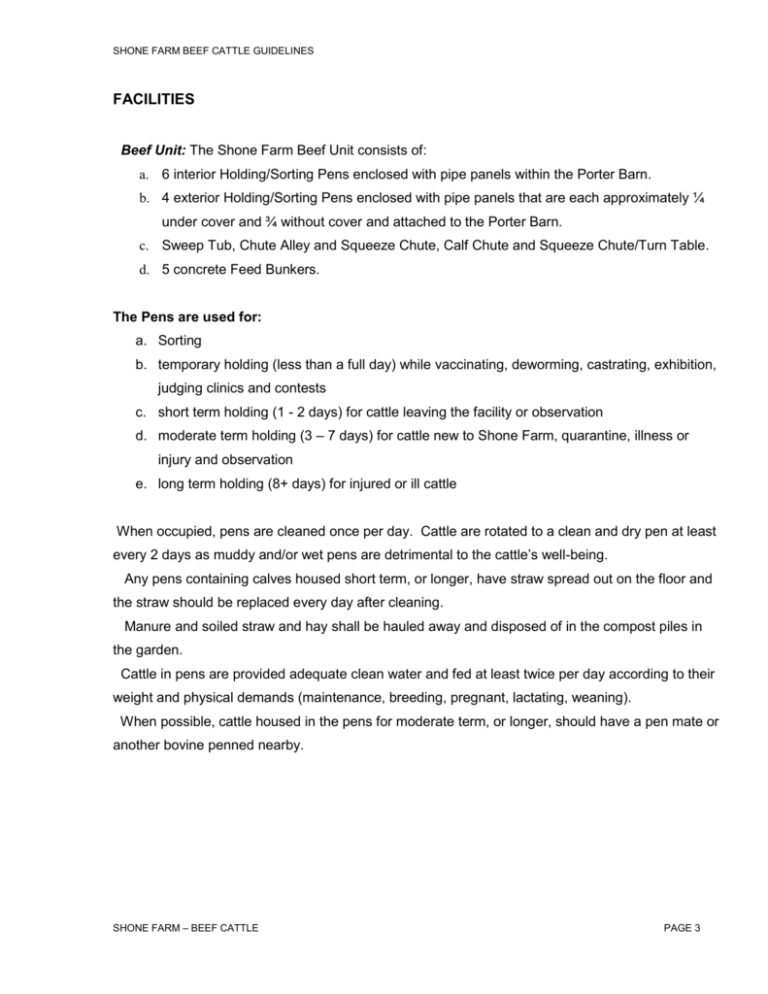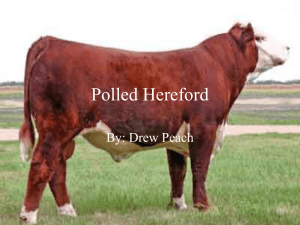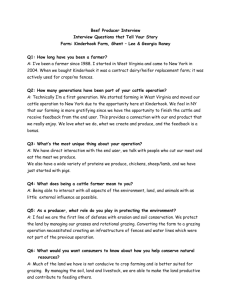shone farm Beef cattle guidelines FACILITIES Beef Unit: The Shone
advertisement

SHONE FARM BEEF CATTLE GUIDELINES FACILITIES Beef Unit: The Shone Farm Beef Unit consists of: a. 6 interior Holding/Sorting Pens enclosed with pipe panels within the Porter Barn. b. 4 exterior Holding/Sorting Pens enclosed with pipe panels that are each approximately ¼ under cover and ¾ without cover and attached to the Porter Barn. c. Sweep Tub, Chute Alley and Squeeze Chute, Calf Chute and Squeeze Chute/Turn Table. d. 5 concrete Feed Bunkers. The Pens are used for: a. Sorting b. temporary holding (less than a full day) while vaccinating, deworming, castrating, exhibition, judging clinics and contests c. short term holding (1 - 2 days) for cattle leaving the facility or observation d. moderate term holding (3 – 7 days) for cattle new to Shone Farm, quarantine, illness or injury and observation e. long term holding (8+ days) for injured or ill cattle When occupied, pens are cleaned once per day. Cattle are rotated to a clean and dry pen at least every 2 days as muddy and/or wet pens are detrimental to the cattle’s well-being. Any pens containing calves housed short term, or longer, have straw spread out on the floor and the straw should be replaced every day after cleaning. Manure and soiled straw and hay shall be hauled away and disposed of in the compost piles in the garden. Cattle in pens are provided adequate clean water and fed at least twice per day according to their weight and physical demands (maintenance, breeding, pregnant, lactating, weaning). When possible, cattle housed in the pens for moderate term, or longer, should have a pen mate or another bovine penned nearby. SHONE FARM – BEEF CATTLE PAGE 3 SHONE FARM BEEF CATTLE GUIDELINES FACILITIES - continued Beef Unit Alley: The Shone Farm Beef Unit Alley consists of 3 sections separated by 2 gates to hold cattle in groups while sorting and/or moving into the sweep tub. There are gates on either end of the alley for cattle to enter and exit at one end and trailer loading at the other end. In addition, there are 3 gates on the Porter Barn side of the alley used to move the cattle into the Pipe Panel Pens, Feed Bunkers and Sweep Tub. There is also a narrow chute-like opening on the Porter Barn side of the alley used for cattle to exit the Pipe Panel Pens. Cattle shall be moved through the alley in as quiet and calm manner as possible using appropriate herding tools [see “Behavior” and “Management Practices (General)”]. Patience is paramount in moving the cattle through the alley and they should be allowed to move forward and methodically as they feel safe and secure. The amount of pressure used to move the cattle shall be only that which is necessary. A scale of 1 – 10 (1 being minimum amount of pressure and 10 being maximum amount of pressure) shall be considered when moving cattle. Handlers shall start with “1” and move up the scale in order to obtain desired results. Pressure should be released immediately as cattle comply and move in the desired direction and manner. Handlers shall not “nag” cattle by constantly yelling at them, rattling paddles or hitting them once the cattle are complying and moving in the desired direction. Handlers should walk quietly behind them outside of kicking distance. Moving small groups (approximately 5) of cattle at a time into the Sweep Tub has the best results and never shall cattle be packed into the Sweep Tub so that the cattle cannot move freely and forward into the chute. Cattle move best in a wide circular or sweeping pattern, therefore, handlers should avoid forcing them to turn in small spaces or circles. Feed Bunkers: The Beef Unit consists of 5 concrete Feed Bunkers equipped with pipe head dividers to allow each animal to comfortably have their own eating area. The Feed Bunker area has a dirt floor that slopes away from the Bunkers. Feed Bunkers are used to feed the cattle hay when the pastures are unavailable and cattle shall be brought up or allowed access to the Feed Bunkers from the Pastures at least 2 times per day to eat. Cattle are not to be housed in the Feed Bunker Alley, therefore, the cleaning may be done by tractor as needed and as determined by the Farm Manager or Livestock Technician. Using a tractor, a thorough cleaning of the Feed Bunker Alley shall be done after the Feed Bunkers are no longer in use. SHONE FARM – BEEF CATTLE PAGE 4 SHONE FARM BEEF CATTLE GUIDELINES FACILITIES – continued Pastures: Although cattle in confinement have minimum space requirements, the amount of land needed for cattle to graze on varies considerably based on several physical factors including, but not limited to amount and type of forage, slope, water access, supplements, type of cattle (cows: maintenance, pregnant, lactating, weaning), calves, bulls and the extend of grazing desired. Shone Farm has 2 irrigated pastures, 2 dry pastures (that grow grass in the wet seasons) and 3 dry smaller pastures used on a temporary basis. Cattle are moved to different pastures based on pasture condition, cattle body condition and nutritional needs (maintenance, pregnant and trimester, lactation, weaning, weaned calves, bulls, steers). Cattle are supplemented with, but not limited to: Orchard Grass Hay; Alfalfa Hay; Iodized Salt Blocks; Lick Tubs when needed. Fencing: Fence statutes are in place to protect livestock, people and property from damage or injury that can be caused by livestock. There are two forms of these laws: Open Range and Closed Range. Local county governments in California determine whether the range will be “open” or “closed” however, most California counties have closed range laws. Closed Range (Fence In): It is the responsibility of the cattle owner to keep their animals contained and enclosed, however, if the cattle break through a fence, the degree of liability of the owner is usually based on normal husbandry practices and if the owner used a “lawful fence”. California Food and Agricultural Code section 17121 describes a “Lawful Fence” as “any fence which is good, strong, substantial and sufficient to prevent the ingress and egress of livestock. No wire fence is a good and substantial fence within the meaning of this article unless it has three tightly stretched barbed wires securely fastened to posts of reasonable strength, firmly set in the ground not more than one rod apart, one of which wires shall be at least four feet above the surface of the ground. Any kind of wire or other fence of height, strength and capacity equal to or greater than the wire fence herein described is a good and substantial fence within the meaning of this article. The term ’lawful fence’ includes cattle guards of such width, depth, rail spacing and construction as will effectively turn livestock.” SHONE FARM – BEEF CATTLE PAGE 5 SHONE FARM BEEF CATTLE GUIDELINES FACILITIES - continued Fences at Shone Farm consist of three different types: 3’ – 4’ Field Fencing with 2 – 3 strands of barbed wire stretched above the Field Fencing, Board Fencing and Board Fencing covered with 1” x 2” Non-Climb wire. All perimeter fences shall be “Lawful Fences” while interior fences may be of lower standard. Water Availability: Cattle should always have access to clean, fresh water and it must be available in sufficient quality and quantity for cattle to drink as they need or want to, without competition. SHONE FARM – BEEF CATTLE PAGE 6







